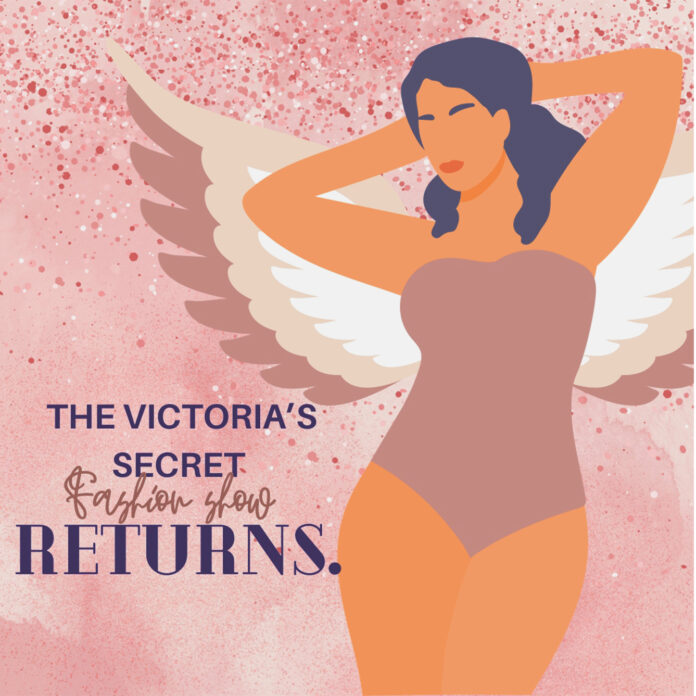For twenty years, angels with 30-pound wings in lingerie reigned cultural influence over societal beauty standards. It wasn’t until six years ago when the image of tall, skinny, and gorgeous women in scanty clothing and stilettos came crashing down with the weight of their wings. In 2018, the “Victoria’s Secret Fashion Show” stopped its annual broadcast and took its fallen angels with them.
Following claims of sexism and anti-feminism, Victoria’s Secret had its last fashion show in 2018, but the brand has been trying to climb back up to relevance since then. Different from its past elaborate fashion shows, Victoria’s Secret came out with a movie, “The Victoria’s Secret World Tour” which was released on Amazon Prime on Sept. 26. The new movie was promoted with the intention of convincing the world of the brand’s newly found inspiration to be “the world’s leading advocate for women,” according to Martin Waters, CEO of the Victoria’s Secret.
The movie showcases the work of 20 women, a “new generation of creatives” from four major cities– London, Tokyo, as well as Bogotá, Colombia and Lagos, Nigeria. Victoria’s Secret hired a team of creatives from each city consisting of one designer, one filmmaker and three other creatives ranging from painters, poets or musicians. These teams of creatives are given the freedom to conceptualize a collection of their own that will be showcased in the movie.
In this new movie, Victoria’s Secret’s approach differs from its past aesthetic of sexed-up, scant and superficial shows. This movie focuses on the idea of what it means to be a woman and replaces its angels, who were prominently tall and skinny models, with a diverse group of women, some of whom are part of the VS Collective. According to the New York Times, the VS collective, established in 2021, is a group of ten women known for their notable accomplishments who advise the brand and appear in ads or, in this case, a movie to promote Victoria’s Secret’s new image.
The movie shows faces from the VS collective, such as Hailey Bieber and Adut Akech. The movie also shows intercuts of other famous women like Naomi Campbell wearing a gold plated piece by Lagos’ designer Bubu Ogisi while narrating a monologue written by Eloghosa Osunde. Doja Cat performed “Attention” wearing an intimate red leather lingerie set with a detailed red-lace cover-up. The movie can be described as a documentary focusing on the group of creatives narrated by former angel, Gigi Hadid, with intercuts of scenes similar to a music video or perfume ad.
Victoria’s Secret seems to have altruistic intentions for this special by giving a huge platform for these women and expecting nothing in return. However, are the brand’s steps “toward advancing gender equality and empowering underserved voices,” as said on the brand’s website, a ploy for monetary gain?
For more than 20 years, the Victoria’s Secret fashion show was an annual event seen as a cultural phenomenon. However, in 2018, the show lost cultural relevance after the #MeToo movement, with critics pointing out that the show objectified women and lacked diversity, according to the New York Times. It also didn’t protect the brand’s dying image when Edward Rezek, Chief Marketing Officer of the company at the time, publicly stated that transgender women should not star in the show, according to Vanity Fair.
It makes one wonder whether the company’s male hierarchy within the company was a red flag, that Victoria’s Secret designed their lingerie for the male gaze, rather than for the desire of women. In 1977, Roy Raymond founded the company in an effort to make men feel more comfortable when shopping for their wives’ underwear according to Stamford Advocate. In addition, Hulu’s Victoria Secret documentary exposes former CEO Leslie Wexner’s connection to convicted sex offender Jeffrey Epstein, according to Time Magazine.
“From a feminist cultural historian point of view, [the brand was] another example of a male-dominated fashion industry making money off of women’s bodies,” says Dr. Clemente, Associate Director of the UNLV public history program, historian and curator of 20th century American culture specializing in fashion. Clemente elaborates that the brand lost pertinence due to the constant evolution of culture so Victoria’s Secret’s method of using “fluffy and puffy wings on 7 feet tall women didn’t have the cultural weight [it used to].”
Victoria’s Secret’s old message that clung to the idea of a woman’s sexiness and unrealistic body goals is out of step with the times. “It’s a new generation of women who don’t identify with that at all,” says Clemente.
With the recent release of “The Victoria’s Secret World Tour,” there is controversy about whether or not Victoria’s Secret is copying Savage X Fenty. Savage X Fenty was founded by musical artist Rihanna, and is a lingerie brand known for its inclusion of all women’s various body types and skin colors.
Since 2019, Fenty has released the Savage X Fenty show on Amazon Prime as a series of different volumes representing the years, as it has become an annual event. Remarkable women, known for their accomplishments, vary in different skin colors and body types in the Fenty Show. Notable women such as Cara Delevingne, Bella Hadid, Willow Smith, and many more have modeled for the show.
Victoria’s Secret’s delayed response to adapt to the times and unoriginal ideas shadow its efforts to promote their brand’s new feminist vision. As a result, it is valid to be skeptical whether or not Victoria’s Secret will be able to wash away the stain of its tainted sexist past and revive itself from the grave that the brand has dug itself.
Clemente states, “These companies have a hard time reinventing themselves because their time is over. So, Fenty is interesting because they are a brand conceived from an internet era, born from the idea of body positivity and different kinds of women diversity … The brand Fenty was conceived in this market, it is born from this market. Victoria’s Secret isn’t born from this market.”

